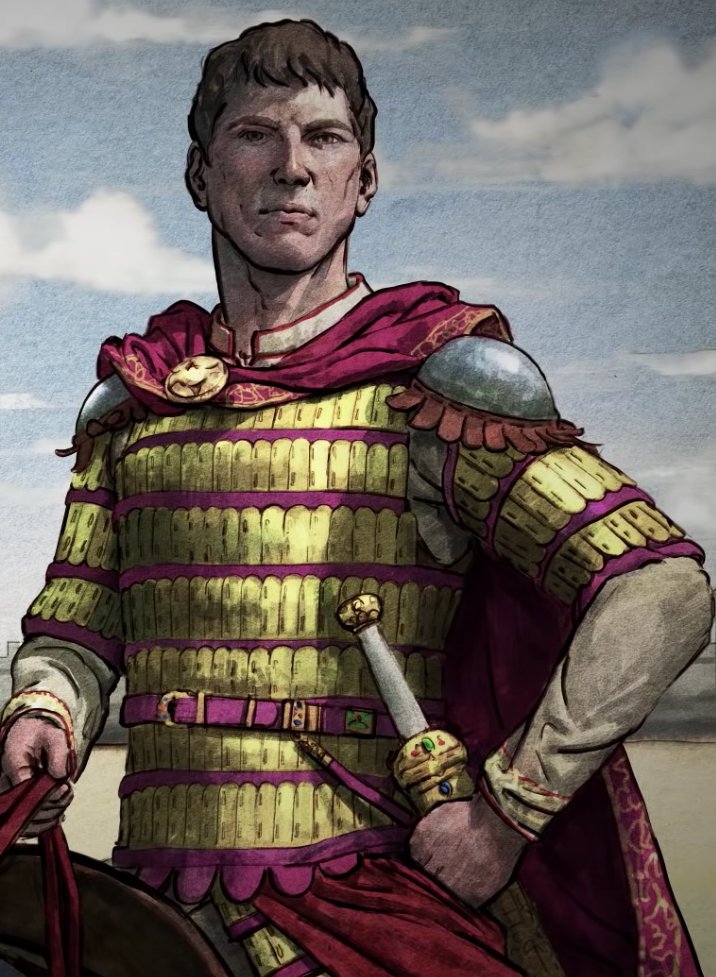Just how large was the Roman army during the reign of Justinian in the sixth century? Direct contemporary evidence is scarce. Modern estimates range from 150,000 to 326,000. Let's dive into the controversy. 🧵 #Roman #Byzantine #History 

Let's start with the number all modern historians must reckon with. The Roman historian Agathias complains about the army during Justinian's reign: "there should have been a total effective fighting force of 645,000 men, but the number dropped to barely 150,000." 

First thing to note is that this total (150,000) is meant to make Justinian's army look small. In other words, it is offered in a polemical spirit, not simply as a factual report. Nevertheless, it's the evidence we have, so we try to do something with it.
Some modern historians have taken these numbers to refer to the Roman army at two different points: 645,000 represents the total army of the Roman Empire in the 4th century, while 150,00 represents only the field armies in the 6th century.
Now we have to divert to define "field armies." These armies, known in Latin as comitatenses, were the mobile striking forces of the Later Roman military, and are contrasted with the frontier armies (limitanei), which were stationed in garrisons along the frontiers. 

In 1995, Warren Treadgold argued that the sixth-century Roman field armies totaled 150,000 and the frontier armies totaled 176,000, putting the total Roman army at 326,000. This analysis both uses and puts in context Agathias' polemical number of 150,000. 

Although I think of this as the Treadgold estimate, it's worth noting that subsequent work by John Haldon (1999), Hugh Elton (2007), and others has not veered far from this number (~300k total army), even if details and methods used to reach that total vary.
Here is Treadgold's reckoning of the sizes of the various field armies at the end of Justinian's reign:
East: 20,000
Armenia: 15,000
Thrace: 20,000
Illyricum: 15,000
Presence I: 20,000
Presence II: 20,000
Africa: 15,000
Italy: 20,000
Spain: 5,000
Total: 150,000
East: 20,000
Armenia: 15,000
Thrace: 20,000
Illyricum: 15,000
Presence I: 20,000
Presence II: 20,000
Africa: 15,000
Italy: 20,000
Spain: 5,000
Total: 150,000

Adding in limitanei, a total Roman army in the sixth century between 300,000 and 326,000 would be about half of the alleged total of 645,000 for the army in the fourth century (when the empire was much larger). So this would make sense.
Very recently, Anthony Kaldellis and Marion Kruse in their book The Field Armies of the East Roman Empire, 361–630 (2023) have attempted to blow up this relative consensus on the size of Justinian's total army. 

They have argued that two critical field armies, known as the "praesental" armies (armies in the presence), began to shrink as early as the reign of Anastasius and were finally completely emptied by Justinian to man his western armies.
If this argument is correct, the two praesental armies, which Treadgold estimated at 20,000 men each, should be removed from the field army total, which subsequently drops from 150,000 to 110,000.
It's an intriguing argument, and I have long suspected that Justinian transferred at least some units from the praesental armies to the West. But I am not yet convinced that the praesental armies completely ceased to exist in the reign of Justinian.
A problem with the Kaldellis/Kruse thesis is what to do with that 150,000 number from Agathias. What does it refer to if not the total of soldiers in the field armies? They suggest 2 possibilities:
1) They suggest that the paper number advertised by the regime was 150,000 in the field armies, even if in actuality the two praesental field armies were practically non-existent. So official numbers and actual numbers were considerably misaligned. Possible!
2) More controversially, to my mind, they suggest that 150,000 could actually be the total army of Justinian's reign, with around 100-110k in the field army and 40-50k in the frontier armies. Less likely!
The problem with this second option is that Justinian's empire had perhaps 15 ducates (frontier army commands) in the 520s, and the emperor created 5 more in Africa in the 530s. That each frontier army consisted of only some 2,000-2,500 men seems unlikely to me.
This thread is already quite long, so we'll wrap up with a question I have received before: why was the army of Justinian "so small" compared to earlier Roman armies? As we have seen in this thread, the likely size of the total army of Justinian wasn't all that small.
Compared to a possible total for the Roman army in the 4th century, when the empire stretched from Egypt to England, the army of Justinian was perhaps half the strength, which is proportionately not that much smaller given the smaller size of his empire.
Campaign armies in Justinian's reign may have been smaller compared to earlier Roman centuries, but that is because these armies were spread around the Mediterranean trying to both hold on to the empire's current territories and retake territories that had been lost. 

It would have been quite risky for Justinian to mass multiple armies together into a campaign force of 50,000-60,000 men in a single location. Just sending some 36,000 or so to the West in the 530s opened up the East to considerable danger from Khusro I in 540. 

Fortunately, for whatever reason, the strategic considerations of Justinian's reign did not really demand campaign forces higher than 20,000-25,000. Justinian's armies were generally a good match for whatever the Romans' enemies could throw at them. Fin.
Tagging @ByzRomanLevant who I know was interested in this issue.
• • •
Missing some Tweet in this thread? You can try to
force a refresh

 Read on Twitter
Read on Twitter



















